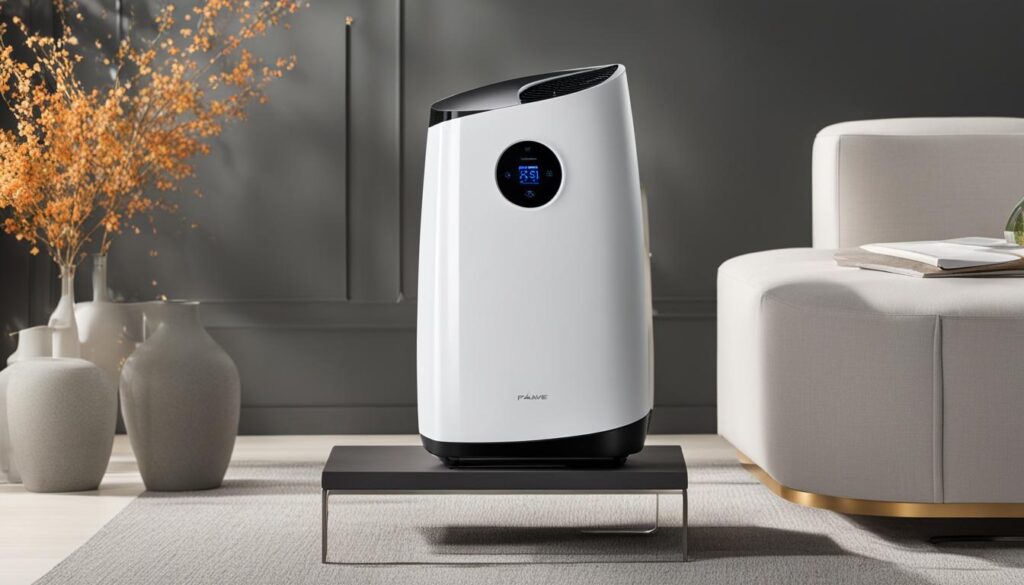Welcome to our article on PlasmaWave technology! If you’ve ever wondered what the buzz is all about or want to learn more about this innovative air purification method, you’ve come to the right place. In this article, we will provide a detailed explanation of PlasmaWave technology, how it works, and its applications. By the end, you’ll have a better understanding of this cutting-edge technology and whether it’s the right choice for your air purification needs.
Contents
Key Takeaways:
- PlasmaWave technology is an air purification technology developed by Winix.
- It uses ionization to remove harmful particulates from the air.
- PlasmaWave technology works by creating charged particles called ions that neutralize pollutants.
- It can effectively remove viruses, bacteria, and mold spores from the air.
- PlasmaWave technology has applications in consumer electronics and healthcare.
The Science Behind PlasmaWave Technology
PlasmaWave technology harnesses the power of bipolar or needlepoint ionization to create charged particles known as ions. These ions play a crucial role in neutralizing harmful pollutants present in the air, making the technology an efficient air purification solution.
Unlike unipolar ionization, which can lead to the production of harmful byproducts, PlasmaWave technology provides a safer alternative. By attracting and recombining with particles carrying an opposite charge, the ions effectively neutralize a wide range of air pollutants.
One of the notable features of PlasmaWave technology is its ability to remove microscopic particles, including viruses, from the air. This makes it an invaluable tool in promoting a cleaner and healthier indoor environment.
Winix, a leading manufacturer of air purifiers, integrates PlasmaWave technology into their products while ensuring the production of only minimal amounts of ozone. This commitment to safety has made Winix air purifiers a popular choice among consumers seeking effective air purification options.
| PlasmaWave Technology Features |
|---|
| Utilizes bipolar or needlepoint ionization |
| Neutralizes harmful pollutants in the air |
| More effective and safer than unipolar ionization |
| Removes microscopic particles, including viruses |
| Produces minimal amounts of ozone |
By harnessing the power of PlasmaWave technology, air purifiers equipped with this innovative feature can effectively improve the air quality in various indoor environments.
The Impact of PlasmaWave Technology in Healthcare Settings
In healthcare facilities, the use of PlasmaWave technology can significantly enhance air quality and reduce the risk of airborne infections. The technology’s ability to remove viruses and other harmful particles makes it a valuable addition to hospitals, clinics, and other healthcare environments where cleanliness and patient safety are of utmost importance.
The Advantages of Using PlasmaWave Technology
PlasmaWave technology offers numerous benefits in air purification, making it an ideal choice for creating a cleaner and healthier environment. By effectively removing harmful particulates, including viruses and mold spores, PlasmaWave technology significantly improves overall air quality.
One of the key advantages of PlasmaWave technology is its wide range of applications. It is utilized in various industries, such as consumer electronics and healthcare, due to its ability to provide exceptional air purification results.
PlasmaWave technology has gained popularity for its effectiveness in eliminating airborne contaminants, making it a reliable solution for enhancing indoor air quality. Whether you’re looking to improve the air in your home, office, or healthcare facility, PlasmaWave technology can effectively remove pollutants and create a safer environment for everyone.
“PlasmaWave technology has revolutionized the way we purify the air. Its ability to remove harmful particles, such as viruses and mold spores, has made it an indispensable tool in healthcare settings.” – Dr. Amanda Thompson, Environmental Health Specialist
Moreover, PlasmaWave technology not only removes harmful particles but also offers long-term benefits. By eliminating pollutants, it reduces the risk of respiratory illnesses and allergies, promoting better health and well-being.
The Benefits of PlasmaWave Technology:
- Effectively removes harmful particulates, including viruses and mold spores
- Improves overall air quality for a healthier environment
- Wide range of applications in consumer electronics and healthcare
- Reduces the risk of respiratory illnesses and allergies
With its exceptional air purification capabilities and versatility in various industries, PlasmaWave technology offers an effective and reliable solution for improving indoor air quality.

Evaluating the Safety of PlasmaWave Technology
The safety and effectiveness of PlasmaWave technology are subjects of debate. While bipolar ionization has shown better results and safety compared to unipolar ionization, solid research on the long-term effects of ionizers is lacking. Ozone, a byproduct of the PlasmaWave process, can be present in varying amounts depending on the device. It is important to consider the potential risks and benefits before using PlasmaWave technology in air purifiers and healthcare settings.
PlasmaWave technology has gained recognition for its potential applications in improving indoor air quality. However, concerns have been raised regarding the safety of ionizers, particularly in environments where vulnerable individuals may be present. Let’s explore the key aspects to consider when evaluating the safety of PlasmaWave technology.
Effectiveness and Safety of Bipolar Ionization
Bipolar ionization, the technology behind PlasmaWave, uses charged particles to neutralize pollutants and potentially harmful particles in the air. Unlike unipolar ionization, which produces harmful byproducts such as ozone, bipolar ionization has been found to be safer and more effective in reducing airborne contaminants.
Research has suggested that bipolar ionization can effectively remove microscopic particles, including viruses, bacteria, and mold spores. It also helps eliminate unpleasant odors and volatile organic compounds (VOCs) that can contribute to poor indoor air quality.
While bipolar ionization shows promise in improving air quality, it should be noted that extensive research on the long-term effects of ionizers is still limited. Therefore, it is crucial to exercise caution and consider potential risks before implementing PlasmaWave technology in air purifiers or healthcare environments.
The Ozone Factor
Ozone is naturally present in the atmosphere and plays a vital role in protecting us from harmful UV radiation. However, elevated levels of ozone can pose health risks, particularly for individuals with respiratory conditions such as asthma or chronic obstructive pulmonary disease (COPD).
PlasmaWave technology generates a small amount of ozone as a byproduct of the ionization process. The production of ozone varies depending on the device and its operating conditions. While Winix products claim to produce minimal levels of ozone within the recommended safety limits, it is essential to verify the ozone emission of specific models before use.
If you have respiratory conditions or concerns about ozone exposure, it is advisable to consult a healthcare professional or consider alternative air purification methods that do not produce ozone.
Considerations for Air Purifiers and Healthcare Settings
When evaluating the safety of PlasmaWave technology for air purifiers and healthcare settings, it is essential to consider specific factors:
- The target audience and their vulnerabilities: Individuals with respiratory conditions or compromised immune systems may be more sensitive to ozone exposure.
- The environment: Ensure proper ventilation in the room to minimize the accumulation of ozone or other byproducts.
- Regulations and guidelines: Familiarize yourself with national and local regulations governing the use of ionizers and ozone-emitting devices in commercial and healthcare settings.
By considering these factors and doing thorough research, you can make an informed decision about whether to incorporate PlasmaWave technology into your air purification systems or healthcare practices.
| Advantages | Considerations |
|---|---|
|
|

Is PlasmaWave Technology Worth Considering?
PlasmaWave technology has gained attention in the field of air purification, offering a unique approach to creating cleaner and healthier air in consumer electronics. However, it is important to consider the effectiveness and safety of this technology before making a decision.
While traditional filter-based air purifiers have been extensively researched and proven to be highly effective, the use of ionization methods like PlasmaWave technology is a matter of personal preference. This technology harnesses the power of ions to neutralize harmful pollutants in the air, including viruses and mold spores, resulting in cleaner indoor environments.
Before incorporating PlasmaWave technology into your consumer electronics, it is crucial to assess your specific needs and consult reputable sources. While PlasmaWave technology shows promise, ongoing research is important to understand its long-term effectiveness and potential risks. Additionally, it is essential to ensure that the PlasmaWave device you choose adheres to safety regulations and produces minimal ozone.
Ultimately, whether PlasmaWave technology is worth considering for your consumer electronics depends on various factors, including your air purification goals, safety concerns, and personal preferences. Stay informed, consult experts, and make an informed decision to create a cleaner and healthier environment in your home or office.
FAQ
What is PlasmaWave technology?
PlasmaWave technology is an air purification technology developed by Winix that uses ionization to remove harmful particulates from the air, such as viruses, bacteria, and mold spores.
How does PlasmaWave technology work?
PlasmaWave technology utilizes bipolar or needlepoint ionization to create charged particles called ions. These ions attract and recombine with particles of opposite charge, effectively neutralizing harmful pollutants in the air.
What are the benefits of PlasmaWave technology?
PlasmaWave technology can effectively remove harmful particulates, including viruses and mold spores, improving the overall air quality. It has applications in consumer electronics and healthcare.
Is PlasmaWave technology safe?
While bipolar ionization has shown better results and safety compared to unipolar ionization, the long-term effects of ionizers like PlasmaWave technology are still being studied. Ozone, a byproduct of the PlasmaWave process, can be present in varying amounts depending on the device.
Should I consider using PlasmaWave technology in air purifiers?
The use of PlasmaWave technology in air purifiers is a matter of personal preference. Traditional filter-based air purifiers are well-researched and proven to be highly effective, so it is important to consider your specific needs and consult reputable sources before deciding on the best air purification method for your environment.




